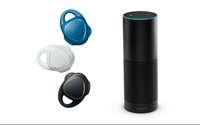 Global revenue from connected smart audio devices is expected to more than triple in the next four years and will come from two distinct types of products.
Global revenue from connected smart audio devices is expected to more than triple in the next four years and will come from two distinct types of products.
By 2020,
more than $5 billion in revenue will be generated from the smart audio market, up from more than $1 billion this year, according to new research from Juniper Research.
Revenues will be driven
into two distinct categories, so-called hearables and smart audio devices within the home, according to Juniper.
Both hearables and unit-based smart audio devices are currently even in their
early adopter stage of the market. However, by the late majority adoption stage, unit-based smart audio devices will leap ahead of hearables to ultimately become the clear market leader, according to
Juniper.
advertisement
advertisement
Use cases for smart audio in hearables include fitness tracking, augmented listening (filtering the sound entering a consumer’s ears) and real-time language translation.
Hearables devices, such as Doppler Labs’ Here Active Listening augmented hearing earbuds and Samsung’s Gear IconX wireless fitness tracking earbuds, will remain niche products and will
experience the most success within the fitness tracking markets, according to Juniper.
Some features seen in fitness focused hearables are heartrate monitors and other biometric sensors
combined with audio coaching, as well as music streaming and general calling capabilities. Most hearables devices currently rely on a smartphone for use, but some brands are developing untethered
options. This appears to be a similar market trend to the smartwatches segments of wearables.
Personal assistant functionality, such as Apple’s Siri, Google’s Assistant,
Microsoft’s Cortana, or Amazon’s Alexa, can be used in hearables, but is better suited for success within standalone voice controlled units in the smart home, according to Juniper.
“Smart speakers win out because while they also need a context, their form factor gives them an almost universal one, while hearables fill specific audio niches,” said James Moar,
author of the study.
“As a result, smart speakers and hearables will fill very different roles, despite relying on similar software capabilities in many cases.”
The
majority of revenue is projected to come from smart audio devices within the home in the form of voice-controlled systems like Amazon’s Echo and Google Home voice assistant.
Consumers
are currently hesitant to the idea of speaking to non-human based systems in public, but that hesitation is lifted when in the comfort of consumers’ homes, according to the study. As a result,
the most success within smart audio devices will come from products operating within that space.